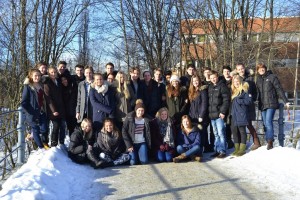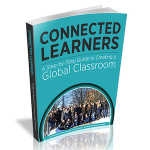 After eight years of teaching in a technology driven high school and after attending workshops, seminars and conferences worldwide, I thought it was about time I challenged both my students and myself.
After eight years of teaching in a technology driven high school and after attending workshops, seminars and conferences worldwide, I thought it was about time I challenged both my students and myself.
I wanted to see if it was possible to find a project that could engage every student in my 9th grade class of English learners and learn if they all could work together as a team. Most of all, I wanted to see if they could produce an end product that would be authentic and involve collaboration with educators and students globally.
I believe they and I succeeded! The evidence: Our publication of the 200-plus page collaborative book Connected Learners: A Step-by-Step Guide to Creating a Global Class....As our press release says, this interactive eBook is
a unique compendium of stories, advice and how-to articles designed to help high school teachers and their students around the globe shift from classrooms that are isolated and teacher-centered to digitally rich environments where learning is student-driven and constantly connected to the global internet.
There are many books on the topic “learning in the 21st century,” and I think I have read most of them. The authors are educators and educational experts I know and admire. Many write about what students want and how students learn. What occurred to me was that there are no books about this topic written by students.
Who are more important in students’ learning than the students themselves? Yet what I discovered was that teachers seldom ask their students important questions about pedagogy and learning. Most often teachers assume that they know what the students want — and that in most cases it’s what the teacher wants.
How our project developed
When I introduced the idea of writing a book in English class, most of my students thought I had completely lost my mind. They imagined it would be just too difficult and that no one would ever want to read it. However, as with most projects, you only need one or two supporters in your group and you are good to go!
 What really helped this project was the fact that we could talk to educators and students in every part of the world through our classroom PLN. I know it was when we were skyping with Silvia Rosenthal Tolisanothat the students really began to think that they might be able to write a book. The fact that she has 50,000 readers of her blog and 17,000 followers on Twitter made a huge impression on them. As one of my students wrote in the book: “I really started to believe in the project when we had a Skype-interview with Silvia Rosenthal. She really had faith in it – thought it was a unique idea and promised to help us promote the book.”
What really helped this project was the fact that we could talk to educators and students in every part of the world through our classroom PLN. I know it was when we were skyping with Silvia Rosenthal Tolisanothat the students really began to think that they might be able to write a book. The fact that she has 50,000 readers of her blog and 17,000 followers on Twitter made a huge impression on them. As one of my students wrote in the book: “I really started to believe in the project when we had a Skype-interview with Silvia Rosenthal. She really had faith in it – thought it was a unique idea and promised to help us promote the book.”
We started the project in January and the 219-page book was completely finished on May 14. Two things really amazed me: the students were on task — and they performed. They were enthusiastic and they worked hard. Early in the process, I asked four students to be project leaders, and they never disappointed me. They stepped up, and they got the job done. I assume the trust I gave them by assigning them to leader roles gave the students the confidence and motivation they need to work harder.
We also appointed chapter editors. We would brainstorm on content and ideas and then the chapter editors had to make sure their topic was covered. Using Microsoft’s SkyDrive and OneNote as a platform for collaboration is great because you can see how text is added and read everyone’s contribution. This way it is easy to share ideas and keep up with what needs to be done.
My thoughts on engagement
Every educator wants to experience the moment of “flow” when all the goals are set and understood and work is moving along easily and naturally. When we read about engaging students in the classroom using technology and social media, authors often leave us with the impression that this work will flow gentle as a stream. When talking about motivation and learning in school, grit is most often left out of the conversation. Yet, according to Daniel Pink, the best predictor of success is grit, defined as perseverance and passion for long term goals.
Our published book proves that when you find the right project — one that really involves all the students — they can find the grit and do what it takes to reach the final objective.
And here’s an interesting fact: The most popular topic to write about in this book turned out to be motivation. It is ironic that motivation and innovation are topics we discuss on almost every level in education, from policy makers and educational experts to school leaders and teachers. We are simply missing the most important link here — we do not spend enough time discussing this with our students. My students’ reflections in this book show us that we should spend a lot more time discussing important topics like motivation, learning, pedagogy and technology with them. In this book, we provide many great examples and discussion topics to get us started.
Reflections from my students
• “I am sure this project has given every one of us a wider range of experiences. Not only have we learned how to write fuller articles (in English) on areas that were of interest to us. We have also gained a much wider vocabulary and knowledge in many different areas. We have taken part in meetings and conversations with people from different parts of the world. In addition, we have learned how to work independently, and at the same time stay focused and motivated throughout the entire process. That can actually be really hard.”
• “Some students are more enthusiastic than others. Our project was no exception, however we managed to motivate each other and lift each other up. As a project leader, I experienced eagerness among my fellow students. If they had some time left, they were quick to ask for something to do. I find this quality very valuable.”
• “In English class, we work with the curriculum goals. I think it is an excellent way to work. Why? Because when you are able to choose to work with something you are interested in, topics that catch your attention, the motivation goes up. I can remember several instances when I actually forgot I was doing school work, because the task I was given was so appealing that I almost could have done it outside school.”
• “This book shows what is possible to achieve by working together. And it shows that learning can be done, not only by cooperating with your fellow students, but also the teacher. “Connected Learners”, will hopefully help teachers use more digital tools, and guide them towards a better school day for both them and the students. My view of how the classroom should be has certainly changed during this project, and I hope this book will inspire more teachers to change the classroom, together with the students.”
Learn more about our book
We’re happy for the support from Powerful Learning Practice and the PL Press, which is offering Connected Learners: A Step-by-Step Guide to Creating a Global Class... for sale at the Powerful Learning Press online bookstore for $5.99. (SL 2.0 Note: Kindle Version for sale at our bookstore for $3.99.) All the profits will go into a travel fund for my students so that we can meet in person some of the other global learners we work with online.
If you like our book, you can leave a review at the PLPress book page and/or share your comments here. And I’d be happy to answer any questions if you think you’d like to engage your own students in a book project!


You need to be a member of School Leadership 2.0 to add comments!
Join School Leadership 2.0